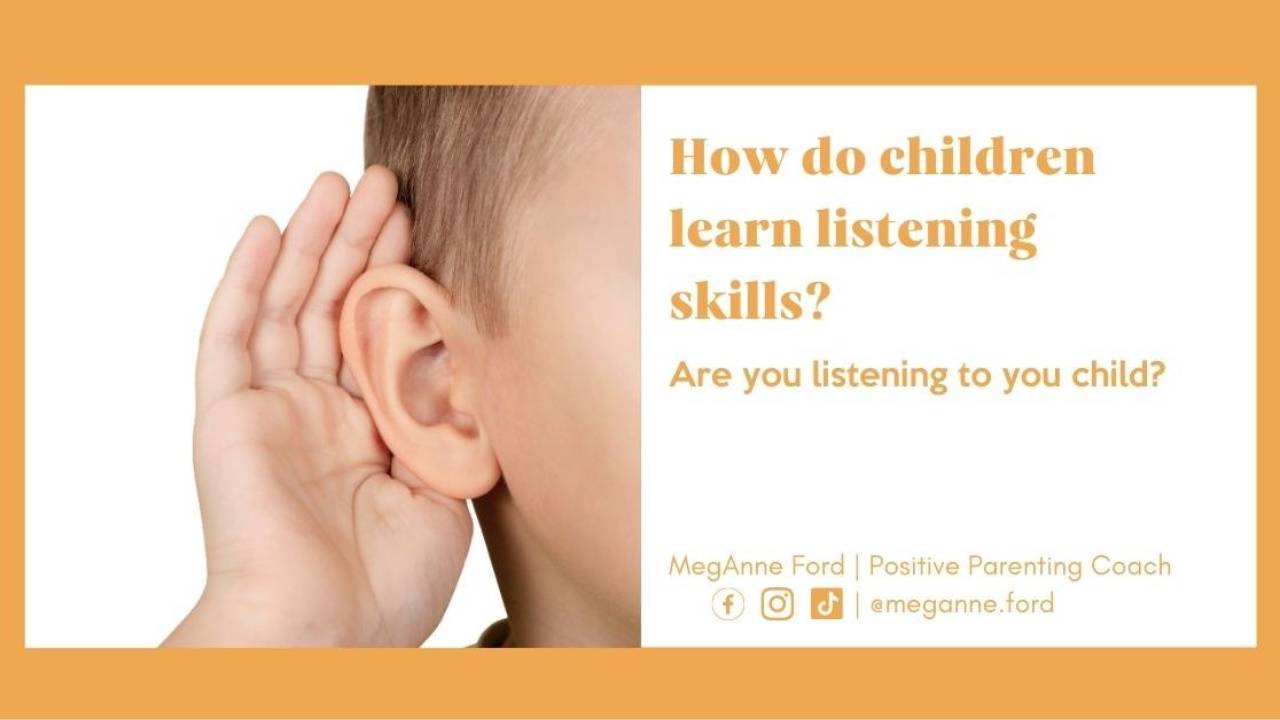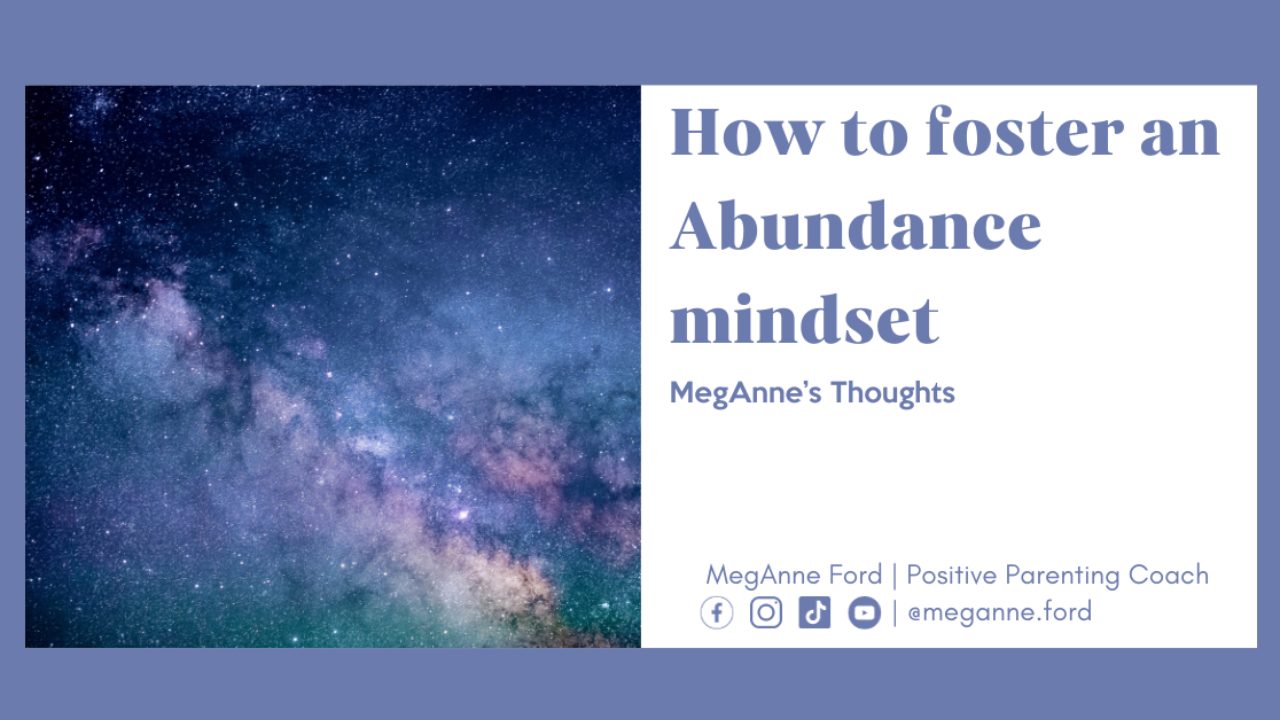
What are regulation, co-regulation, dysregulation, and auto-regulation?
Jun 29, 2023
You can WATCH or LISTEN to this content
Trigger warning with this content. I invite you to listen to your body and take a break if you feel triggered reading this content.
Co-regulation is a vital aspect of fostering emotional well-being and resilience. The concept of co-regulation is important in maintaining healthy relationships and supporting individuals in managing their emotional states effectively.
Takeaways
- Co-regulation is the shared process of regulating emotions and maintaining emotional balance within relationships, which promotes emotional well-being and resilience for both individuals involved.
- Healthy co-regulation involves empathetic attunement, active listening, and providing support to others during times of emotional distress, fostering a sense of safety and trust in relationships.
- Co-regulation plays a crucial role in promoting emotional self-regulation skills, enhancing social connections, and reducing the negative impact of stressors on mental health.
- Recognizing the importance of co-regulation allows individuals to cultivate healthier relationships, foster emotional growth, and build a supportive network that can contribute to overall well-being.
"Just calm down!" "Just try harder!"
Calming yourself does not work in a command form. It is a process.
I am sure you have experienced moments when someone wanted you to calm down and said it in a command form, making you even angrier or feel stuck.
When you are in a heightened state, you have a stressed, nervous system that you must process. To help move through, you can bring awareness, education, and practice process.
As I do in my coaching, I bring awareness to open up into education to balance it into practice.
We will bring awareness to our nervous system, its job, how we calm down, and why it matters to talk about this.
What does our nervous system do for us?
The nervous system is our brain, spinal cord, and all the nerves running through our bodies. We have control over our muscle movement, but our heartbeats, digestion, and stress response are outside of our control. Those work automatically.
Our nervous system has a built-in system to maintain balance or maintain regulation, involving the neurotransmitters, which are biochemicals that allow nerves to communicate or transmit that information together.
Some common neurotransmitters are:
Dopamine: feelings of pleasure or reward
Serotonin: our mood, appetite, or sleep.
The nervous system controls our stress reactions, and our stress reactions control our nervous and hormonal systems.
When we think about regulation, we feel what it is like in our bodies. As our thermostat cools down, we will rest, and our parasympathetic nervous system kicks in, and we can digest food, absorb nutrients, and have a robust immune response.
This is all happening outside our control.
When we think of dysregulation, we heat up and create an energetic flow, our sympathetic nervous system kicks in. We go into alert. Our pupils dilate, our heart rate increases, and our sweat activates. This turns off our growth and digestion.
Both systems of being are normal. We need the parasympathetic system to grow and process and the sympathetic system to stay safe and survive.
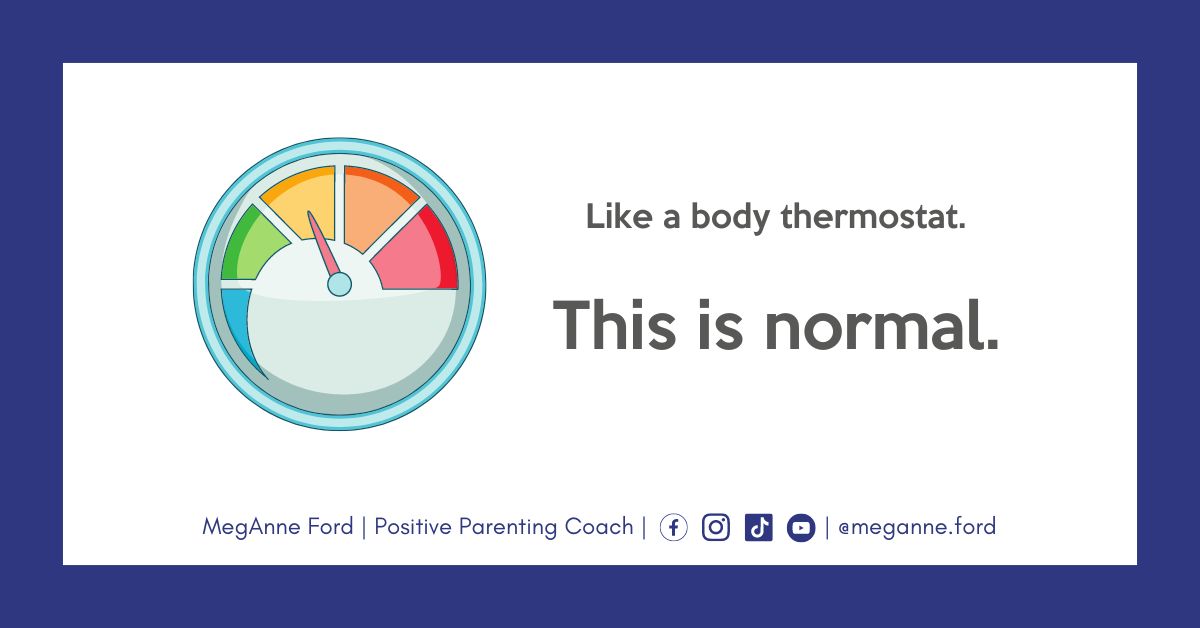
This was a very quick introduction to the nervous system. As we discussed in "Is non-verbal communication important," different ways we communicate, now we will look at how we behave through stress levels.
How we behave through stress
How we behave through stress depends on the level of stress, coping skills, and duration.
Children also can rely on support from their parents through co-regulation.
Think back to your childhood. In your moments of stress, how did your parents respond? Were they able to help you regulate, or did they aggravate your stress?
What is regulation?
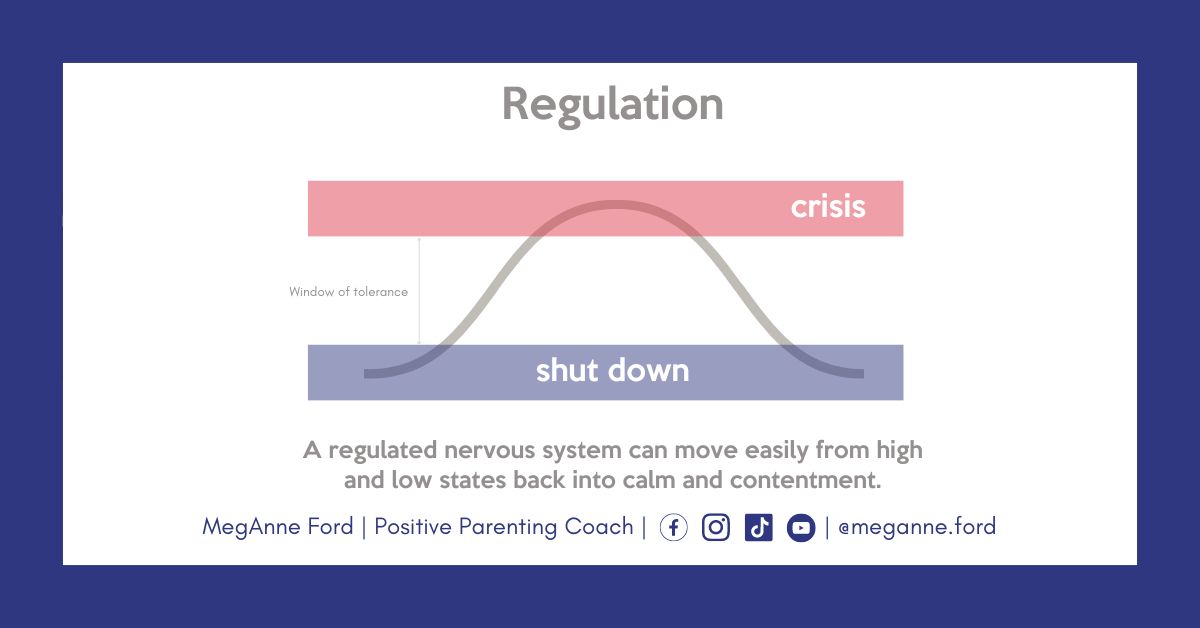
Regulation is the ability to exert control over one's emotional state. Imagine a dial that is in control of your regulation. You can realize that the dial is moving towards the red zone, and you have tools and techniques to cool yourself down or discern, "Yes, in fact, I do need to stay in the red zone."
Regulation is the ability to exert control over this imaginary dial, to control your emotional state.
The sympathetic and parasympathetic, we can look at the scale, at the low end, way cooled off, is a place of total rest and sleep.
Unsurprisingly, it is hard to sleep when we create a lot of chaos and stress around bedtime. This is also true when going through a stressful point in our own life.
Even such things as credit card debt can negatively affect your sleep.
Sleep is the cool end of the spectrum. The stress response (fight, flight, freeze, and ) is the opposite.
There is drowsy, hypo-aroused, calmly focused and alert, and hyper-aroused in the middle.
In the book "Self-Reg: How to help your child and Break the stress cycle and successfully engage in Life" by Dr. Shanker, a quote that stayed with me is;
"The more aware we are of when we're becoming overstressed, and know-how to break this cycle, the better we self-regulate: in other words, manage the myriad stresses in our lives. The autonomic nervous system (ANS) reacts to stress with metabolic processes that consume energy and then set compensating processes that promote recovery and growth in motion. The greater our stress load, the more constrained this recovery process, and as a result, the fewer our resources to exercise self-control and the more intense our impulses become."
The greater our stress load, when our stress load is flooding, when we are becoming overwhelmed, the more constrained the recovery process is.
That is why we start to lose sleep, that is why we stop eating, and that is why we don't take care of ourselves. It's more strain on that recovery process.
We have fewer resources to exercise self-control, there is not enough gas in our tank to regulate ourselves, and it isn't easy to be your best self moving forward.
You're going to make mistakes. You'll have poor emotion control, snippy, intense impulses, and lashing out.
Children show this very clearly. When they are tired, their resources are out they cannot control themselves. We sometimes call this the "witching hour," sometime in the afternoon before dinner when everyone's resources have been depleted, and it makes sense because we have a higher stress load during that time.
The zones of regulation are similar to a bell curve, the low ends are when we are hitting shut down, and the high point or peak is when we are in crisis. A crisis is when everyone feels intense, loud, and so much at once.
The space between the low and high is when we feel calm, regulated, comfortable, capable, and confident. It is your window of tolerance.
The window of tolerance is what you can handle.
A regulated nervous system can quickly move from high to low states and back into calm and contentment based on how wide that window of tolerance is.
I am sure you can picture people in your life that have a very narrow window of tolerance. They either shut down or strongly react with little outside influence.
I know that when I don't get enough sleep or food, I become a bubbly mess and start crying. My husband sometimes even comes to me a asks, "Hey, love, have you eaten today?" My response is a blubbering "No." He is picking up that my window of tolerance is narrower than usual, my ability to regulate myself is inhibited, and my windows of stress are bigger.
What is dysregulation?

Dysregulation is a poor ability to manage emotional responses or to keep them within an acceptable range of typical emotional reactions.
Imagine if it is in the middle of the summer and you have your heat on. You might start sweating a lot, be lethargic, might feel the need to drink more water because your body is trying to regulate itself. Or, imagine in the dead of winter during a blizzard, you had your ac running. It might freeze your pipes you might get hypothermia because you are not attuned to regulate yourself.
Dysregulation, when running hot, means little inconveniences create stress and crisis.
When people start to say, "It's not that bad. You just need to calm down."
Think about when children are navigating homework or their favorite toy breaks or when they want the blue cup.
We tend to go into the 'just calm down!'
We are witnessing that when they've peaked into crisis, their window of tolerance is very small, and that cup just put them over the edge.
Knowing now about our nervous system, we can take a moment and see something is off. I don't need to add more stress. I need to help relieve the stress.
Dysregulation when running cold that looks like any inconveniences create a high amount of shutdown; we start to avoid things and disconnect.
We hear or say, "You just need to try harder."
So whether it is a hot or cold response, we can identify that they are entering into dysregulation. The window of tolerance might be very small, and it doesn't take much for them to get tripped into a crisis or shut down.
A quote from Dr. Delahook's blog during the Covid pandemic, "Finding our way back: How Trauma-Responsive Practices can Help us Face this Moment," that helps us understand stressors is
"In order to learn, children need to feel regulated in their bodies. How do we help them to regulate themselves? We redefine behaviors beyond the surface level. Unfortunately, too many teachers have been trained to focus on getting children to comply rather than on emotional regulation—which is what they need. The more challenging the behaviors, the more vulnerable the child's nervous system.
Ross Greene frames it this way: behaviors are the signal, and shouldn't be the target of our interventions. We shouldn't punish children for the signals they send, but rather use them to discover what lies beneath the child feels unsafe on a physiological level. Now, more than ever before, we need to go beyond behaviors to the underlying meanings...So it starts with us, with the adults in the room. Children want to please us, and if they can't, there's a reason. "
There is a reason when you are acting a certain way, or they are acting a certain way, or anyone in your life is acting a certain way. They're acting that way for a reason.
There is a reason, and you as the person of power in the parent-child relationship. The parent has got to do the work first.
We aim to become curious about what's happening, not to fix and rescue but to ease and support. Sign up for the Be Kind Coaching mailing list to learn how I can support you in doing the work first.
Dysregulation has that same bell curve, but the crisis and shutdown blocks are wider, lessening the window of tolerance.
Meaning it is going to take less to create a big response.
For example, if you didn't sleep well the night before and didn't eat breakfast, your parents were getting on you because you were running late. Then you got into a fight about the shoes and then you misspelled a word on your spelling test. You forgot your lunch money, got teased on the playground, and then came home, and your parents now wondered why you hadn't done the dishes, and you explode at them, or the opposite, you run to your room and keep your distance.
Imagine if the adults in your life started to understand that your expression of emotion is only giving them information. It has nothing to do with how you feel about them or that you disrespect them.
We can all take this information and start to lean into co-regulation.
What is co-regulation?

Co-regulation is a warm and responsive interaction that provides support, coaching, and modeling for children. When their gauges are cranked up, co-regulation helps teach them how to regulate themselves. It helps them understand, express, and modulate their thoughts, feelings, and behaviors. It is the adult supporting the child in moments of stress with the goal of soothing and process the stress.
In those moments, the adult must be able to regulate their thermostat so we can help the child regulate their thermostat. We become the support and not the weight. We start soothing the stress, not adding more stress to it.
"Co-regulation is a neuro-relational phenomenon that occurs when two or more brains are in a synchronous connection. Basically, the brains are in tune with one another. This attunement brings a sense of connection which translates into safety. Our brains consistently assess our environment for safety, and our senses are used to evaluate the appearance and behavior of others. Once the sense of safety is identified, there is a myriad of reactions that bring our level of arousal to match that of those around us."
- Dr. Kevin Hull- The Role of Co-Regulation in Parenting
When we co-regulate, we share our calm rather than in their chaos.
There are many ways to regulate yourself and keep yourself regulated, and no two people or situations are alike. Breathing, touching, and calming your voice, just like we covered in "Is nonverbal communication important?" our non-verbal cues can help as well, softening our tones, offering a cool drink, some people use ice to kick on their nervous system to regulate themselves, sometimes it's going for a walk, sometimes it's listening to music, there are so many tools.
Since no two people are the same regarding how they get regulated, we must do our part, know what tools are in our toolbox, or create a toolbox.
Now imagine the adult is regulated, and the child comes to them dysregulated. Their window of tolerance is very small. When we co-regulate, we help them increase their level of tolerance.
REMINDER: Expect reactivity in the other person, why? Because the other person is quick to stress, shut down, and lash out. Their responses are going to be big. Their words will be bitter, and their attacks will be strong because they are in a stressful space.
What we can also do in co-regulation is model our emotional regulation.
We have an opportunity to share what we have with the child because this is an asymmetrical relationship.
The child's role is to bring it to us so we can help soften the waves together.
Co-Dysregulation
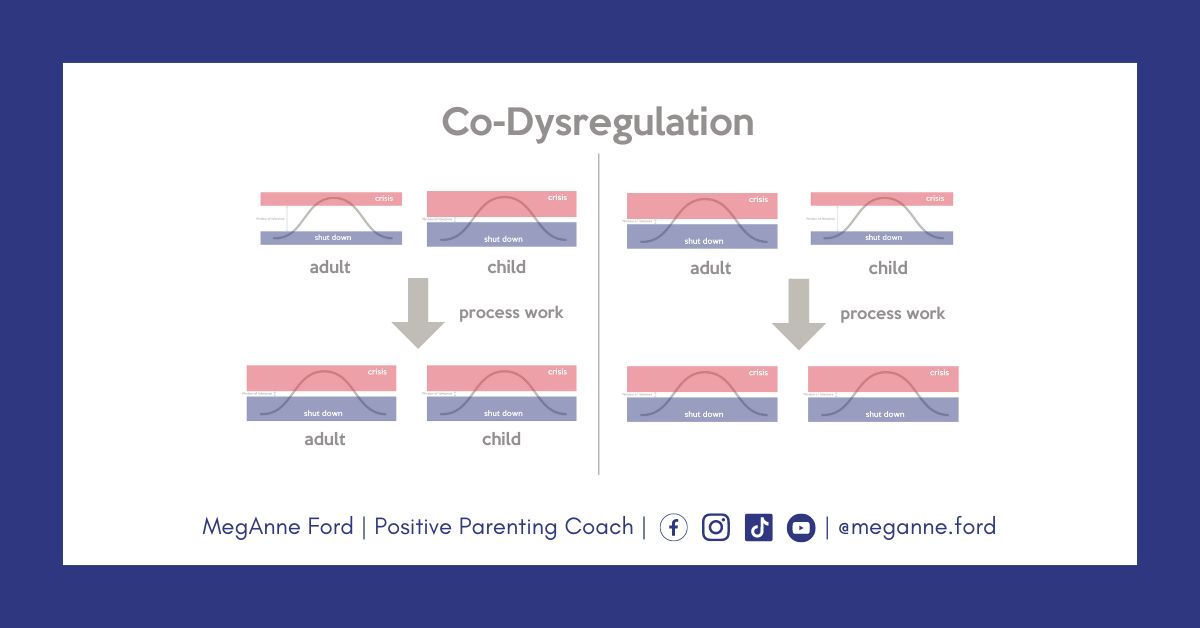
Co-dysregulation is when the adult is calm, the child is stressed, and then we become stressed. Now that both the adult and child are stressed, we have shared our stress. This is when our boundaries are unclear, and our discernment is unpracticed.
It can also work in the opposite way where the child is calm and the adult distressed, and the adult shares their stress with the child. Again both become dysregulated both feel more stress.
This reminds me of my favorite quote from Heim Ginott's "Teacher and Child; A book for Parents and Teachers."
"I have come to the frightening conclusion that I am the decisive element. It is my personal approach that creates the climate. It is my daily mood that makes the weather. I possess tremendous power to make life miserable or joyous. I can be a tool of torture or an instrument of inspiration, I can humiliate or humor, hurt or heal. In all situations, it is my response that decides whether a crisis is escalated or de-escalated, and a person is humanized or de-humanized. If we treat people as they are, we make them worse. If we treat people as they ought to be, we help them become what they are capable of becoming."
I feel like when we're thinking about dysregulation. This beautiful quote says, you can share your calm, or you can share your chaos.
When someone brings chaos, there is a beautiful opportunity to share your calm. Help them by supporting them through the stress.
They can shift into autoregulation as they learn to be supportive and supported and learn these tools for themselves.
What is Auto-Regulation?
Auto-regulation or self-regulation is regulating yourself without intervention from external bodies, the ability to regulate yourself without any reliance on outside forces.
These foundational skills are developed with the caregiver early in our childhood.
Many therapies seek to cultivate these skills that weren't modeled for us, for those with gaps, myself included. Learning and building these toolboxes helps widen the tolerance window is hard work.
Autoregulation can be maladaptive or adaptive.
Maladaptive means that they are serving you in hurtful ways. They might soothe the stress, but it might be a short-term fix, where long-term starts to create more stress ultimately.
Over Control - It looks like solving made-up problems, micromanaging, and shifting into solving problems for other people. Maybe we fix a problem, and then it falls apart again, so we think we need to push ourselves harder, be perfect, and get it under control. The "I will just do it because no one else will."
Passive - Deny responsibility, reject it, put up the defenses, we have relinquished control. Maybe, we have become the victim. There is just no use in trying. "It is just what it is."
In both instances, it serves us in the short term but applied long term, it can become maladaptive. We will continue to hit the same problems repeatedly because the strategy is limiting.
Adaptive means that they are helpful to you. They are something that supports you long-term.
Active - To take an active approach means to rely on resources, ask for help, and do the work to get into a space where you can start to problem solve from a calm, cool, and collected space. Within the window of tolerance.
I am very good at solving my problems in a state of stress or a state of shutdown that creates more stress or shutdown. The times when I'm scrolling on TikTok, that's me in a passive stance, it is protective at the moment, but long term, it won't help me solve what I'm struggling with. So in those moments, I can shift into becoming more active, I can ask for help, I can problem solve, I can regulate myself, I can start asking myself questions like;
- What can I do to make it better?
- What is the lesson here?
- What have I learned before that can help me now?
- How can I move?
- Who can support me?
- Who do I need to contact, even when it's hard?
- Who do I feel safe with?
This allows us to get back into our bodies.
Reaching out for support can look different for everyone. Maybe it is free support with friends and family or paid support with a therapist or parenting coach.
The Be Kind Coaching Community is a container built to hold you with purpose, awareness, education, and practice—a place where you can safely share that you are over capacity and need support.
Another adaptive process is to surrender to the solution. Not to give up complete control but to surrender to the uncontrollable.
Questions to ask yourself when you practice surrendering are;
- Where should I be investing?
- Where do I feel calm?
- What feels safe?
A great example of discerning if it is safe is when we think of when it is raining outside.
Am I trying to stop the rain, or I'm trying not to get wet?
I can start to become active in my problem-solving because if I'm trying to solve the problem of stopping the rain, that will be a fool's mission. I am not in control over the weather, but I am in control over if I get wet in the rain.
I can shift into becoming active by understanding the circumstance.
I can also ask myself, will my effort with support change the outcome? If it won't change the outcome, then it is a circumstance, and can we surrender to it?
So, it can look like focusing on what is in your control and releasing all attachment and energy to what is not in control.
I use the rainstorm example because so often, especially as a teacher, as soon as it starts to rain, we're like, "Oh great, it's going to be a terrible day!" We're already attached to what this day will be when it rains. The kids aren't going to go outside. They're going to be so energetic.
We've now surrendered our power to the rain. This is something outside our control versus saying, "Hey, it's raining outside. We're not going to be able to go outside. What are things that we can do inside to expel energy?"
What can I do inside to help solve my problem versus just being like well, it's going to be a lousy day.
Focusing on what is in your control.
Surrendering to what is outside of your control.
Ask yourself if help and support will help get you the outcome you want.
Autoregulation is the process of becoming high in that stress state and then working to navigate into a wider window of tolerance. The ability to regulate yourself in moments of high stress.
I have been practicing auto-regulation for many years, and I still catch myself getting caught using maladaptive tools. This is why I say we practice in times of peace. It is hard, but if you're like me, an adult working through this process, I hope we can empathize with the children working on this.
When we see a five-year-old in front of us struggling to get their homework done, get their shoes on, play with friends, and be nice to their siblings, we can understand that it is a struggle for them to regulate their emotions.
We can give a little grace and start to now soothe the child by supporting them, lessening their load.
This is the more challenging part, we need to be able to have our support network in place so we, too, can have the load lessened.
Questions for you:
- How would you describe your stress capacity?
Were there times reading that you said to yourself, "Oh yes, I see times that I have a wider or narrower tolerance gap."
- When stress is activated, how easily can you regulate yourself?
- How easily can you get back into a state of calm?
- What supports you in navigating to a calmer state?
- What does your behavior look like when you are stressed?
- What does your child's behavior look like when they are stressed?
- In those moments, are you acting as a weight or support?
Are we helping guide through, or are we piling on?
If a child is stressed about the color of a cup, then adding more punishment, shame, or disconnection gives them more stress to navigate through.
On the flip side, if you are stressed by the color of a cup, by ignoring it, by avoiding it by complaining about it, maybe adding more stress onto your plate.
Navigating through stress is an important, meaningful, and valuable space to begin exploring and becoming curious.






